Weijian Xu
Phi-4-Mini-Reasoning: Exploring the Limits of Small Reasoning Language Models in Math
Apr 30, 2025Abstract:Chain-of-Thought (CoT) significantly enhances formal reasoning capabilities in Large Language Models (LLMs) by training them to explicitly generate intermediate reasoning steps. While LLMs readily benefit from such techniques, improving reasoning in Small Language Models (SLMs) remains challenging due to their limited model capacity. Recent work by Deepseek-R1 demonstrates that distillation from LLM-generated synthetic data can substantially improve the reasoning ability of SLM. However, the detailed modeling recipe is not disclosed. In this work, we present a systematic training recipe for SLMs that consists of four steps: (1) large-scale mid-training on diverse distilled long-CoT data, (2) supervised fine-tuning on high-quality long-CoT data, (3) Rollout DPO leveraging a carefully curated preference dataset, and (4) Reinforcement Learning (RL) with Verifiable Reward. We apply our method on Phi-4-Mini, a compact 3.8B-parameter model. The resulting Phi-4-Mini-Reasoning model exceeds, on math reasoning tasks, much larger reasoning models, e.g., outperforming DeepSeek-R1-Distill-Qwen-7B by 3.2 points and DeepSeek-R1-Distill-Llama-8B by 7.7 points on Math-500. Our results validate that a carefully designed training recipe, with large-scale high-quality CoT data, is effective to unlock strong reasoning capabilities even in resource-constrained small models.
Phi-4-Mini Technical Report: Compact yet Powerful Multimodal Language Models via Mixture-of-LoRAs
Mar 03, 2025Abstract:We introduce Phi-4-Mini and Phi-4-Multimodal, compact yet highly capable language and multimodal models. Phi-4-Mini is a 3.8-billion-parameter language model trained on high-quality web and synthetic data, significantly outperforming recent open-source models of similar size and matching the performance of models twice its size on math and coding tasks requiring complex reasoning. This achievement is driven by a carefully curated synthetic data recipe emphasizing high-quality math and coding datasets. Compared to its predecessor, Phi-3.5-Mini, Phi-4-Mini features an expanded vocabulary size of 200K tokens to better support multilingual applications, as well as group query attention for more efficient long-sequence generation. Phi-4-Multimodal is a multimodal model that integrates text, vision, and speech/audio input modalities into a single model. Its novel modality extension approach leverages LoRA adapters and modality-specific routers to allow multiple inference modes combining various modalities without interference. For example, it now ranks first in the OpenASR leaderboard to date, although the LoRA component of the speech/audio modality has just 460 million parameters. Phi-4-Multimodal supports scenarios involving (vision + language), (vision + speech), and (speech/audio) inputs, outperforming larger vision-language and speech-language models on a wide range of tasks. Additionally, we experiment to further train Phi-4-Mini to enhance its reasoning capabilities. Despite its compact 3.8-billion-parameter size, this experimental version achieves reasoning performance on par with or surpassing significantly larger models, including DeepSeek-R1-Distill-Qwen-7B and DeepSeek-R1-Distill-Llama-8B.
Olympus: A Universal Task Router for Computer Vision Tasks
Dec 12, 2024Abstract:We introduce Olympus, a new approach that transforms Multimodal Large Language Models (MLLMs) into a unified framework capable of handling a wide array of computer vision tasks. Utilizing a controller MLLM, Olympus delegates over 20 specialized tasks across images, videos, and 3D objects to dedicated modules. This instruction-based routing enables complex workflows through chained actions without the need for training heavy generative models. Olympus easily integrates with existing MLLMs, expanding their capabilities with comparable performance. Experimental results demonstrate that Olympus achieves an average routing accuracy of 94.75% across 20 tasks and precision of 91.82% in chained action scenarios, showcasing its effectiveness as a universal task router that can solve a diverse range of computer vision tasks. Project page: https://github.com/yuanze-lin/Olympus_page
Rethinking Visual Prompting for Multimodal Large Language Models with External Knowledge
Jul 05, 2024Abstract:In recent years, multimodal large language models (MLLMs) have made significant strides by training on vast high-quality image-text datasets, enabling them to generally understand images well. However, the inherent difficulty in explicitly conveying fine-grained or spatially dense information in text, such as masks, poses a challenge for MLLMs, limiting their ability to answer questions requiring an understanding of detailed or localized visual elements. Drawing inspiration from the Retrieval-Augmented Generation (RAG) concept, this paper proposes a new visual prompt approach to integrate fine-grained external knowledge, gleaned from specialized vision models (e.g., instance segmentation/OCR models), into MLLMs. This is a promising yet underexplored direction for enhancing MLLMs' performance. Our approach diverges from concurrent works, which transform external knowledge into additional text prompts, necessitating the model to indirectly learn the correspondence between visual content and text coordinates. Instead, we propose embedding fine-grained knowledge information directly into a spatial embedding map as a visual prompt. This design can be effortlessly incorporated into various MLLMs, such as LLaVA and Mipha, considerably improving their visual understanding performance. Through rigorous experiments, we demonstrate that our method can enhance MLLM performance across nine benchmarks, amplifying their fine-grained context-aware capabilities.
Florence-2: Advancing a Unified Representation for a Variety of Vision Tasks
Nov 10, 2023Abstract:We introduce Florence-2, a novel vision foundation model with a unified, prompt-based representation for a variety of computer vision and vision-language tasks. While existing large vision models excel in transfer learning, they struggle to perform a diversity of tasks with simple instructions, a capability that implies handling the complexity of various spatial hierarchy and semantic granularity. Florence-2 was designed to take text-prompt as task instructions and generate desirable results in text forms, whether it be captioning, object detection, grounding or segmentation. This multi-task learning setup demands large-scale, high-quality annotated data. To this end, we co-developed FLD-5B that consists of 5.4 billion comprehensive visual annotations on 126 million images, using an iterative strategy of automated image annotation and model refinement. We adopted a sequence-to-sequence structure to train Florence-2 to perform versatile and comprehensive vision tasks. Extensive evaluations on numerous tasks demonstrated Florence-2 to be a strong vision foundation model contender with unprecedented zero-shot and fine-tuning capabilities.
Convolutions and Self-Attention: Re-interpreting Relative Positions in Pre-trained Language Models
Jun 10, 2021



Abstract:In this paper, we detail the relationship between convolutions and self-attention in natural language tasks. We show that relative position embeddings in self-attention layers are equivalent to recently-proposed dynamic lightweight convolutions, and we consider multiple new ways of integrating convolutions into Transformer self-attention. Specifically, we propose composite attention, which unites previous relative position embedding methods under a convolutional framework. We conduct experiments by training BERT with composite attention, finding that convolutions consistently improve performance on multiple downstream tasks, replacing absolute position embeddings. To inform future work, we present results comparing lightweight convolutions, dynamic convolutions, and depthwise-separable convolutions in language model pre-training, considering multiple injection points for convolutions in self-attention layers.
Pose Recognition with Cascade Transformers
Apr 14, 2021



Abstract:In this paper, we present a regression-based pose recognition method using cascade Transformers. One way to categorize the existing approaches in this domain is to separate them into 1). heatmap-based and 2). regression-based. In general, heatmap-based methods achieve higher accuracy but are subject to various heuristic designs (not end-to-end mostly), whereas regression-based approaches attain relatively lower accuracy but they have less intermediate non-differentiable steps. Here we utilize the encoder-decoder structure in Transformers to perform regression-based person and keypoint detection that is general-purpose and requires less heuristic design compared with the existing approaches. We demonstrate the keypoint hypothesis (query) refinement process across different self-attention layers to reveal the recursive self-attention mechanism in Transformers. In the experiments, we report competitive results for pose recognition when compared with the competing regression-based methods.
Co-Scale Conv-Attentional Image Transformers
Apr 13, 2021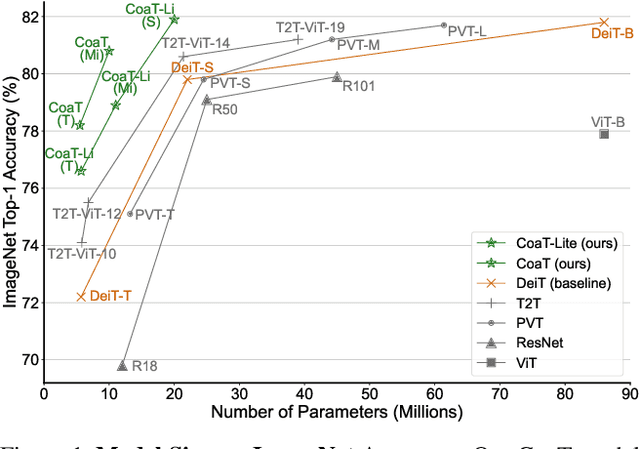
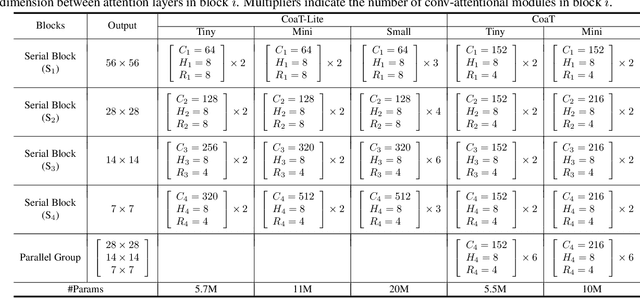
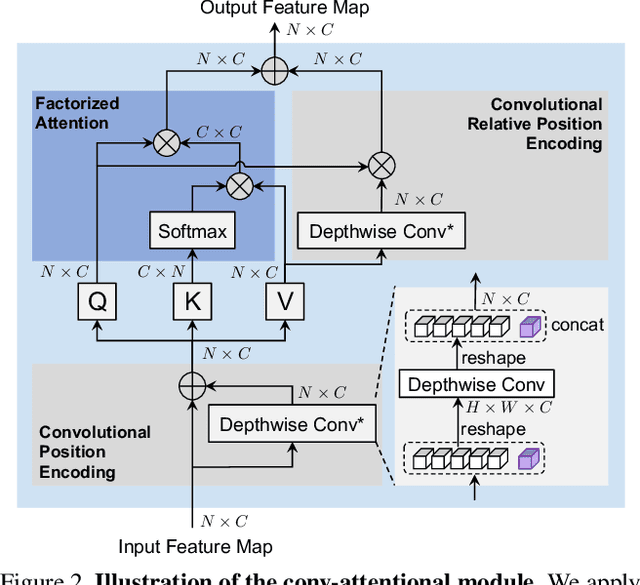
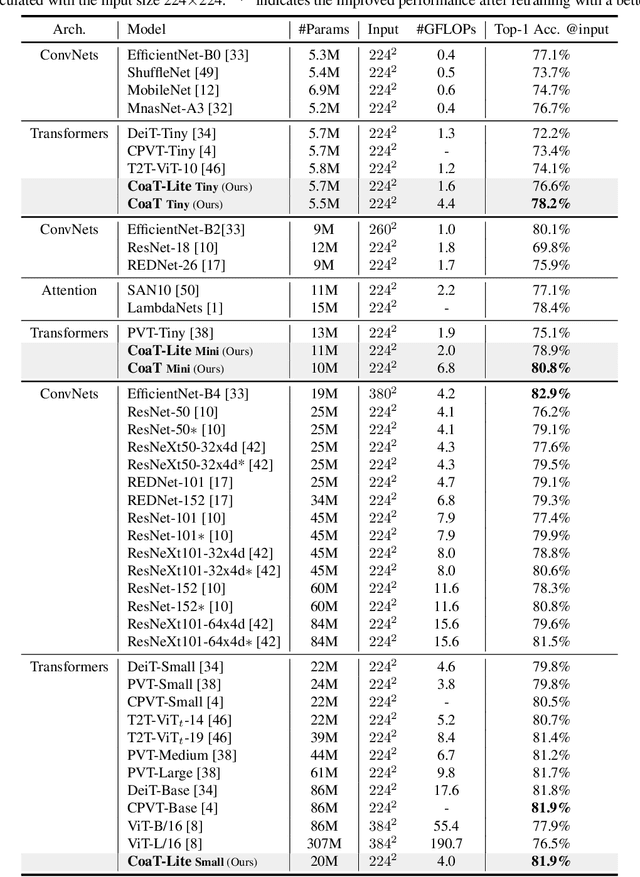
Abstract:In this paper, we present Co-scale conv-attentional image Transformers (CoaT), a Transformer-based image classifier equipped with co-scale and conv-attentional mechanisms. First, the co-scale mechanism maintains the integrity of Transformers' encoder branches at individual scales, while allowing representations learned at different scales to effectively communicate with each other; we design a series of serial and parallel blocks to realize the co-scale attention mechanism. Second, we devise a conv-attentional mechanism by realizing a relative position embedding formulation in the factorized attention module with an efficient convolution-like implementation. CoaT empowers image Transformers with enriched multi-scale and contextual modeling capabilities. On ImageNet, relatively small CoaT models attain superior classification results compared with the similar-sized convolutional neural networks and image/vision Transformers. The effectiveness of CoaT's backbone is also illustrated on object detection and instance segmentation, demonstrating its applicability to the downstream computer vision tasks.
Line Segment Detection Using Transformers without Edges
Jan 06, 2021



Abstract:In this paper, we present a holistically end-to-end algorithm for line segment detection with transformers that is post-processing and heuristics-guided intermediate processing (edge/junction/region detection) free. Our method, named LinE segment TRansformers (LETR), tackles the three main problems in this domain, namely edge element detection, perceptual grouping, and holistic inference by three highlights in detection transformers (DETR) including tokenized queries with integrated encoding and decoding, self-attention, and joint queries respectively. The transformers learn to progressively refine line segments through layers of self-attention mechanism skipping the heuristic design in the previous line segmentation algorithms. We equip multi-scale encoder/decoder in the transformers to perform fine-grained line segment detection under a direct end-point distance loss that is particularly suitable for entities such as line segments that are not conveniently represented by bounding boxes. In the experiments, we show state-of-the-art results on Wireframe and YorkUrban benchmarks. LETR points to a promising direction for joint end-to-end detection of general entities beyond the standard object bounding box representation.
Guided Variational Autoencoder for Disentanglement Learning
Apr 02, 2020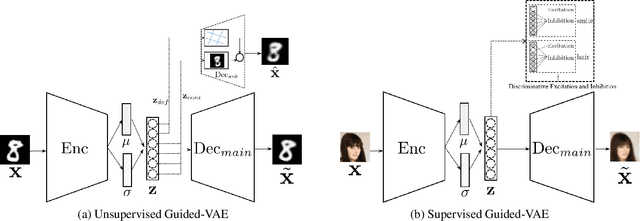
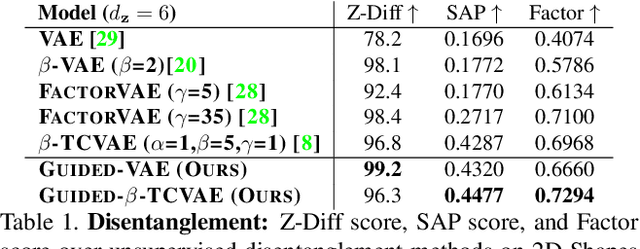


Abstract:We propose an algorithm, guided variational autoencoder (Guided-VAE), that is able to learn a controllable generative model by performing latent representation disentanglement learning. The learning objective is achieved by providing signals to the latent encoding/embedding in VAE without changing its main backbone architecture, hence retaining the desirable properties of the VAE. We design an unsupervised strategy and a supervised strategy in Guided-VAE and observe enhanced modeling and controlling capability over the vanilla VAE. In the unsupervised strategy, we guide the VAE learning by introducing a lightweight decoder that learns latent geometric transformation and principal components; in the supervised strategy, we use an adversarial excitation and inhibition mechanism to encourage the disentanglement of the latent variables. Guided-VAE enjoys its transparency and simplicity for the general representation learning task, as well as disentanglement learning. On a number of experiments for representation learning, improved synthesis/sampling, better disentanglement for classification, and reduced classification errors in meta-learning have been observed.
 Add to Chrome
Add to Chrome Add to Firefox
Add to Firefox Add to Edge
Add to Edge